Two resources for native species reforestation in Panama
/A couple of years ago the Smithsonian Tropical Research Institute (STRI) published a “how to” guide to reforestation using native species in Panama in hardcover. They recently released the publication in digital form. This report summarizes the findings of STRI’s effort to identify commercially viable native timber species and increase adoption of these species among farmers and forestry project promoters.
STRI researchers also released another paper that looks at mixed native species plantations’ growth rates for 5 species: yellow wood (Terminalia Amazonia), rosewood (Dalbergia Retusa), spiny cedar (Pachira Quinata), espave sp. (Anacardium Excelsum), and tropical oak (Tabebuia rosea). This paper is relevant to us because all 5 species are present in our plantations (the espave and tropical oak occur naturally). Interestingly, the study finds that each of the species yielded more biomass when planted together (mixed plantations) than when they were planted as monocultures. The yellow wood did best--something we’ve seen anecdotally in PE’s plantations.
We were happy to see that for the most part our plantations implemented all of the best practice guidance now catalogued in this new guide.
Panama, and especially the Darién, desperately need more native species restoration, so we are pleased about these two new resources. All of the species Planting Empowerment planted in our mixed native species plantations are considered in one or both of these resources, and we will continue to measure our plantations and share the results so that others can learn from our experience.
Our operations are open to the public, so if you’re ever going to be in Panama or visiting the Darien, just send us a note and we can arrange for a tour.








